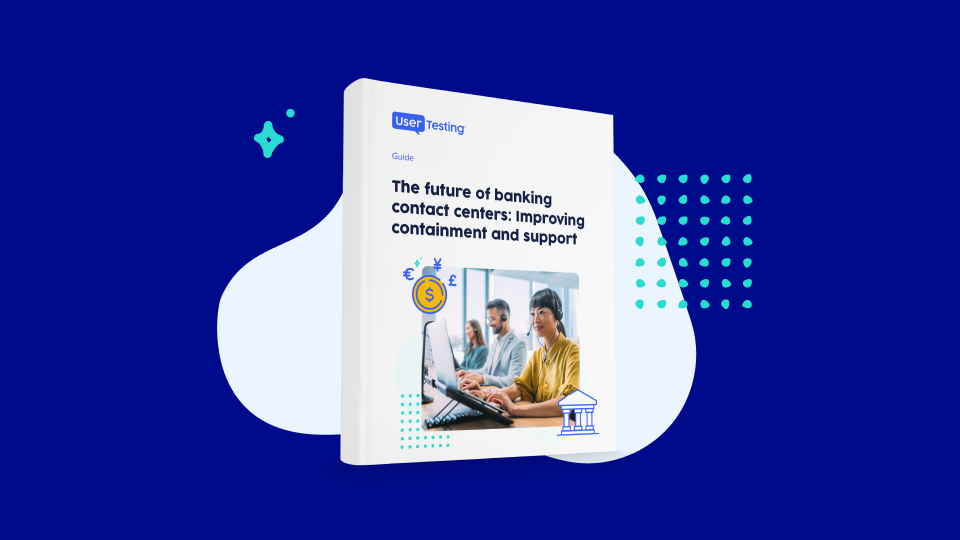
How to modernize your banking experiences to deliver better CX

If you think about what’s transforming businesses today, whether you’re in the banking space or otherwise, it boils down to the customer experience (CX). And this fundamental shift from focusing on products and services to honing in on customer experiences is arguably being driven by industries outside of banking. So how do banks (of all shapes and sizes), retail or commercial, keep up with consumers’ shifting expectations?
Below, we’ll outline how CX is changing the game for banking and how you can provide and benchmark your self-service experiences to exceed your customers’ needs and outperform the competition.
Table of contents
- The evolving landscape of the banking industry
- Optimize digital touchpoints to meet changing expectations
- Uncover consumer banking expectations
- Benchmark banking experiences
- Hear from our customers
The evolving landscape of the banking industry
Today, organizations are competing against the best experience their customers have ever had. Consumers have grown accustomed to top services and experiences that typically accompany well-equipped, larger organizations, which are now expected across all industries. This is a fundamental shift in how you have to market yourself, influence your prospects, and engage with your customers, especially if you are a smaller business with fewer resources.
To keep pace with the changing expectations of consumers, it makes sense to pay attention to customer experience ROI. Delivering and fine-tuning your CX involves a mix of in-person and digital experiences. The digital landscape is inevitably growing. And it’s making it easier for competitors to cater to consumers' changing attitudes and financial needs. As an increasing number of brands begin to modernize their CX, it's getting harder for players who are still relying on traditional methods to keep up.
Keep reading for the steps you need to take to keep up with the competition while retaining and boosting your customer base.
Optimize digital touchpoints to meet changing expectations
More and more, consumers are breaking away from traditional methods of banking—like going into physical branches for transitions and reaching out to call centers for support. In fact, in 2019, 80% of customers of the top 10 banks in developed markets were digitally active. As of 2020, 50% of consumers report interacting with their bank through mobile apps or websites at least once a week, compared to 32% two years ago. And thanks to increasing wait times to call centers thanks to COVID-19 impacts, customers are increasingly looking to solve issues themselves before contacting support. Organizations can make this easier for consumers by prioritizing customer empathy and predicting their needs and questions ahead of time.
4 in every 5 people are attempting to solve banking issues themselves before contacting support.
If these numbers surprise you, or even if they don’t, they do relay a sense of urgency for providing digital experiences and solutions that meet and ideally exceed your consumers’ needs. This idea of digital transformation is not a new concept in the finance world, but it’s one with which companies still struggle.
Organizations spend billions of dollars to understand their customers through data, but the insight provided is limited at best. Your business likely has a CRM platform that shows you how you interact with your customers, an analytics platform to show you how your customers interact with your product, and a survey management platform to help you understand your consumers’ sentiments. However, these tools or metrics can’t place you in your customers’ shoes.
How does it feel to use your banking app or website? How are your digital touchpoints interconnected? How seamlessly can you solve problems on your own, and what are the pain points? Without answers to these questions, it can be difficult to provide the digital experiences your consumers want and need.
Uncover consumer banking expectations
When it comes to understanding consumer expectations, the best way to begin is quite simple. Start by asking the right questions to the right audience.
In a previous test performed on the Human Insight Platform, we asked a diverse group of participants to attempt to extend their overdraft using their mobile banking app. During the test, we asked several follow-up questions, and some key insights emerged.
The first takeaway is that self-service is preferred as a channel:
- FAQs emerged as the first port of call as opposed to Live Chat
- Some apps are clunky and outdated vs. challenger banks/other industries
- Speed and ease of use are crucial customer needs
See for yourself, and listen to some of the highlights from our test.

As you can see, this test reiterates the fact that data doesn’t have all the answers—and can’t replace human insights in revealing how your customers feel about an experience. In just a few hours, thanks to unmoderated testing, we uncovered the personal narratives of real people to understand how they experience banking technology.
Benchmark banking experiences
Consumers increasingly have high expectations for financial privacy and protection and customized experiences. So which banks are getting it right?
In a study run by the UK government, customers were more likely to recommend newer banks to friends and family. Below, here were the top rankings.

Source: Ipsos
So, what can you do to stay competitive and drive loyalty? Banks that are deeply connected to their customers are, first and foremost, customer-centric. To start, you can ask users what they like and dislike about your banking experiences and give yourself every advantage by staying deeply connected with them. You can even run benchmarking studies or leverage the UserTesting competitor evaluation template against your competition to help you uncover the advantages of your competition that you might want to apply to your own business.
Hear from our customers

UK retail bank Tesco Bank serves more than five million customers across a variety of banking, insurance, and money services, with aims to help their consumers better manage their money. Their team recognized the importance of customer empathy for mitigating risk, especially during the discovery phase of projects. In one of their many studies, the Customer Design team leveraged the UserTesting platform to test and compare in-store ads for credit cards—and listened to user feedback to settle internal debates and pick the best option.
Modernize your digital self-service offering
While all banks aim to be customer-centric, the digital world is changing what that means. As we transition into an economy where consumers seek top-notch experiences and leave once they’re no longer receiving this, it’s imperative that you include consumer feedback throughout your development process. Many businesses are asking for feedback way too late, or not at all. And this can result in a massive waste of time, resources, and bottom line.
Banks aren't going digital for no reason. There are real benefits and ROI for banks that make customer-centricity and customer empathy their #1 goal. The best path to customer-centric self-service experiences is to start talking to your customers and target audiences today—and early and often. By continuously collecting user feedback at each stage of the development process, you’ll ensure that you’re delivering the products and experiences your customers want and need.

The future of banking contact centers
Discover key trends shaping the future of banking contact centers and how to improve customer experience.





